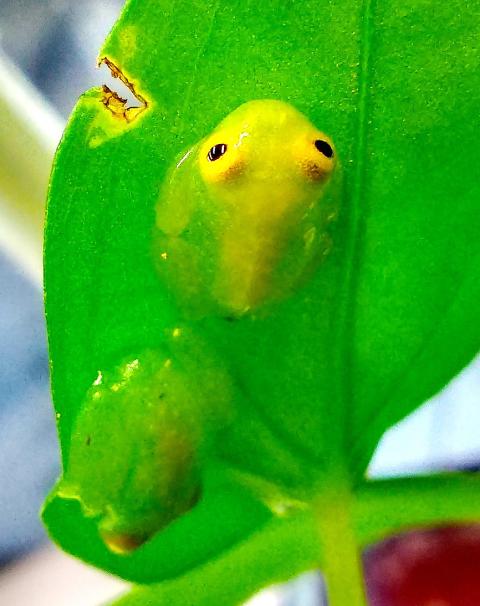Taipei Zoo’s Amphibian and Reptile House yesterday announced that Fleischmann’s glass frogs at the zoo had laid a clutch of eggs that had metamorphosed and were taking to the trees, their natural habitat.
The frogs, like other glass frogs, are named for their near-translucent skin. Fleischmann’s glass frogs, or Hyalinobatrachium fleischmanni, are most commonly found in the tropical forests of Central and South America, and are nocturnal and arboreal, the zoo said.
The frogs are small and delicate, with adults growing to 2cm to 3cm in length, it said, adding that they are adept at climbing.

Photo courtesy of Taipei Zoo
It is interesting to see them open their eyes, it said. Watching their large, protruding eyes emerge looks a lot like pop-up headlights opening on a car.
The primarily green frogs can change color with their surroundings, providing them with excellent camouflage, the zoo said.
Their reproduction practices are interesting, with the female frog typically laying a clutch of eggs on the underside of a leaf near a stream, the zoo said.
Once the tadpoles hatch, they drop into the water, where they burrow into mud until they have matured into young frogs, at which point they take to the trees, the zoo said.
The average hatching time is two to three weeks, while it takes five or six months for the tadpole to metamorphose into a frog, the zoo said.
The current batch of junior frogs have all resumed arboreal life, although it would take sharp eyes to spot them given their size, the zoo said.
Glass frogs tend to sit on the undersides of leaves, which helps them hide from predators, it said.

NUMBERS IMBALANCE: More than 4 million Taiwanese have visited China this year, while only about half a million Chinese have visited here Beijing has yet to respond to Taiwan’s requests for negotiation over matters related to the recovery of cross-strait tourism, the Tourism Administration said yesterday. Taiwan’s tourism authority issued the statement after Chinese-language daily the China Times reported yesterday that the government’s policy of banning group tours to China does not stop Taiwanese from visiting the country. As of October, more than 4.2 million had traveled to China this year, exceeding last year. Beijing estimated the number of Taiwanese tourists in China could reach 4.5 million this year. By contrast, only 500,000 Chinese tourists are expected in Taiwan, the report said. The report

Temperatures are forecast to drop steadily as a continental cold air mass moves across Taiwan, with some areas also likely to see heavy rainfall, the Central Weather Administration (CWA) said. From today through early tomorrow, a cold air mass would keep temperatures low across central and northern Taiwan, and the eastern half of Taiwan proper, with isolated brief showers forecast along Keelung’s north coast, Taipei and New Taipei City’s mountainous areas and eastern Taiwan, it said. Lows of 11°C to 15°C are forecast in central and northern Taiwan, Yilan County, and the outlying Kinmen and Lienchiang (Matsu) counties, and 14°C to 17°C

SHIPS, TRAINS AND AUTOMOBILES: The ministry has announced changes to varied transportation industries taking effect soon, with a number of effects for passengers Beginning next month, the post office is canceling signature upon delivery and written inquiry services for international registered small packets in accordance with the new policy of the Universal Postal Union, the Ministry of Transportation and Communications said yesterday. The new policy does not apply to packets that are to be delivered to China, the ministry said. Senders of international registered small packets would receive a NT$10 rebate on postage if the packets are sent from Jan. 1 to March 31, it added. The ministry said that three other policies are also scheduled to take effect next month. International cruise ship operators

STEERING FAILURE: The first boat of its class is experiencing teething issues as it readies for acceptance by the navy, according to a recent story about rudder failure The Hai Kun (海鯤), the nation’s first locally built submarine, allegedly suffered a total failure of stern hydraulic systems during the second round of sea acceptance trials on June 26, and sailors were forced to manually operate the X-rudder to turn the submarine and return to port, news Web site Mirror Daily reported yesterday. The report said that tugboats following the Hai Kun assisted the submarine in avoiding collisions with other ships due to the X-rudder malfunctioning. At the time of the report, the submarine had completed its trials and was scheduled to begin diving and surfacing tests in shallow areas. The X-rudder,